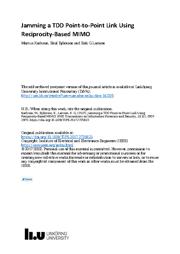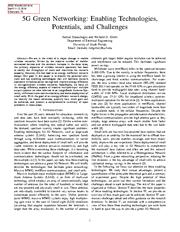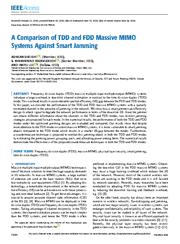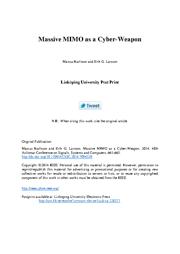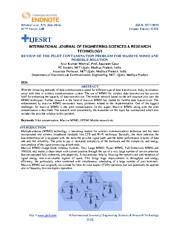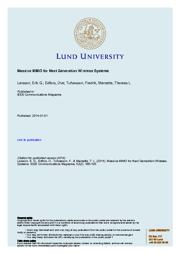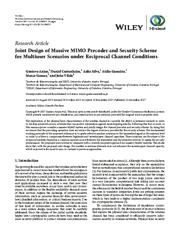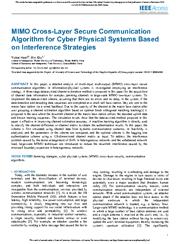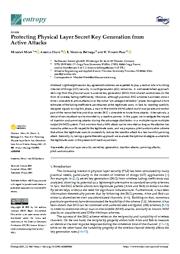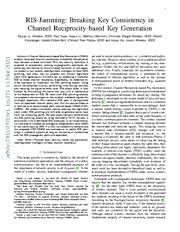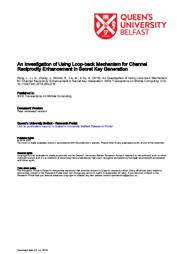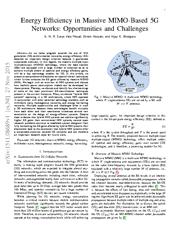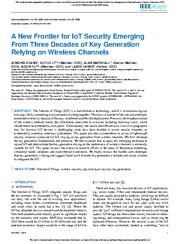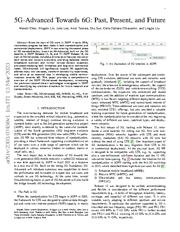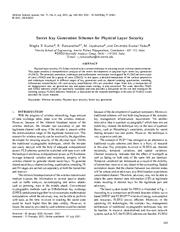A copy of this work was available on the public web and has been preserved in the Wayback Machine. The capture dates from 2018; you can also visit the original URL.
The file type is application/pdf.
Filters
Jamming a TDD Point-to-Point Link Using Reciprocity-Based MIMO
2017
IEEE Transactions on Information Forensics and Security
We present a method for jamming a time-division duplex link using a transceiver with a large number of antennas. ...
The jammer operates without any prior knowledge of channels to the legitimate transmitters, or the legitimate signals by relying on channel reciprocity. ...
The initial idea of using a reciprocity-based MIMO jammer to attack a point-to-point TDD in [32] , in which we covered the frequency-flat case. ...
doi:10.1109/tifs.2017.2725823
fatcat:rgiy7gs6hfgrhdaja6jat53pva
5G green networking: Enabling technologies, potentials, and challenges
2016
2016 IEEE 17th Annual Wireless and Microwave Technology Conference (WAMICON)
We are in the midst of a major change in mobile wireless networks. ...
However, this has lead to an energy inefficient network design. ...
Massive MIMO, mmWave, and Small Cells Applications A fully synchronized TDD-based HetNet deployment in which a macrocell base station employs massive MIMO with an underlay of small cell deployments using ...
doi:10.1109/wamicon.2016.7483860
fatcat:37wuie6psfaixnn65olvhwrue4
A Comparison of TDD and FDD Massive MIMO Systems Against Smart Jamming
2020
IEEE Access
Our results show that despite more attention to the TDD mode in current massive MIMO systems, it is more vulnerable to smart jamming attacks compared to the FDD mode which results in a smaller SE-gap between ...
Furthermore, a countermeasure technique is proposed to combat this jamming attack in both the TDD and FDD modes by estimating the jamming power, grouping users, and allocating power among them. ...
In massive MIMO systems, a large number of antennas are used at the base stations (BSs) that serve low-complexity user equipments (UEs) [1] . ...
doi:10.1109/access.2020.2987606
fatcat:4rznhkihdbfqlnou36lbcyoiuu
Massive MIMO as a cyber-weapon
2014
2014 48th Asilomar Conference on Signals, Systems and Computers
BACKGROUND Massive MIMO refers to using large numbers, a hundred or more, of phase-coherently operating antennas at a wireless base station. ...
Abstract-A scheme for a multi-antenna jammer, jamming a SISO primary link working in TDD mode is presented. ...
doi:10.1109/acssc.2014.7094529
dblp:conf/acssc/KarlssonL14
fatcat:otc7tzxjcndntertgzy245yheu
Review Of The Pilot Contamination Problem For Massive Mimo And Possible Solution
2016
Zenodo
The use of MIMO for wireless data transmission has proven itself for enhancing the capacity of data transmission. The mobile network based on the cell structure also uses the MIMO techniques. ...
Further research in the field of massive MIMO has started for faithful data transmission. The enhancement by massive MIMO encounters many problems related to the implementation. ...
Furthermore, we showed how the macro base station (BS) can leverage the reciprocity-based interference covariance matrix information to significantly improve the SC throughput in a reverse-TDD mode. ...
doi:10.5281/zenodo.57041
fatcat:cbmvgaoa4vd2bpxebhcrxe6r3e
Massive MIMO for next generation wireless systems
2014
IEEE Communications Magazine
Multi-user Multiple-Input Multiple-Output (MIMO) offers big advantages over conventional point-to-point MIMO: it works with cheap single-antenna terminals, a rich scattering environment is not required ...
Other benefits of massive MIMO include the extensive use of inexpensive low-power components, reduced latency, simplification of the media access control (MAC) layer, and robustness to intentional jamming ...
Acknowledgement The authors would like to thank Xiang Gao, doctoral student at Lund University, for her analysis of channel measurements presented in figures 6-7, and the Swedish organizations ELLIIT, ...
doi:10.1109/mcom.2014.6736761
fatcat:ck7fdjukvvdp7m5543clahl5v4
Joint Design of Massive MIMO Precoder and Security Scheme for Multiuser Scenarios under Reciprocal Channel Conditions
2017
Wireless Communications and Mobile Computing
These rotations use the phase of the reciprocal wireless channel as a common random source between the transmitter and the intended receiver. ...
To assess the security performance, the proposed joint scheme is compared with a recently proposed approach for massive MIMO systems. ...
The authors in [29] suggested a secrecy scheme that uses the reciprocal channel phase to randomly define discrete jamming signals. ...
doi:10.1155/2017/5396092
fatcat:ekwrr3l72rep5ppcycgqckjcyu
MIMO Cross-Layer Secure Communication Algorithm for Cyber Physical Systems Based on Interference Strategies
2020
IEEE Access
sent to the macro base station via a wired backhaul. ...
A machine learning algorithm is directly used to classify the channel difference or channel matrix to obtain the authentication results. ...
For TDD systems, channel reciprocity can be used to estimate the channel characteristics of the downlink by transmitting training sequences on the uplink. ...
doi:10.1109/access.2020.3045482
fatcat:moxw2abfh5hs5hj4yjo76kgoaq
Protecting Physical Layer Secret Key Generation from Active Attacks
2021
Entropy
users to successfully reduce the injection attack to a less harmful jamming attack. ...
In this paper, we investigate the impact of injection and jamming attacks during the advantage distillation in a multiple-input–multiple-output (MIMO) system. ...
Next, we assume that Alice and Bob perform SKG in a TDD-MIMO system with a spatially uncorrelated channel. ...
doi:10.3390/e23080960
fatcat:pxgeo5jcsbgaxmiha3v45obkoy
RIS-Jamming: Breaking Key Consistency in Channel Reciprocity-based Key Generation
[article]
2024
arXiv
pre-print
Channel Reciprocity-based Key Generation (CRKG) exploits reciprocal channel randomness to establish shared secret keys between wireless terminals. ...
We also experimentally demonstrate the RIS jamming attack by using commodity Wi-Fi devices in conjunction with a fabricated RIS prototype. ...
In the attack, the reciprocal direct link between the legitimate parties is jammed by the RIS-induced link, effectively reducing reciprocity. ...
arXiv:2303.07015v2
fatcat:3yywwq6cvzc4tic3myywmeo67u
An Investigation of Using Loop-back Mechanism for Channel Reciprocity Enhancement in Secret Key Generation
2018
IEEE Transactions on Mobile Computing
This paper investigates enhancing the channel reciprocity using a loop-back scheme with multiple frequency bands in time-division duplex (TDD) communication systems, in order to mitigate the effect of ...
Physical layer security key generation exploits unpredictable features from wireless channels to achieve high security, which requires high reciprocity in order to set up symmetric keys between two users ...
This paper presents a detailed investigation of using loop-back mechanism for TDD key extraction to improve the channel reciprocity. ...
doi:10.1109/tmc.2018.2842215
fatcat:fk5wmnirlfdzlmt7wp63tozd24
Energy Efficiency in Massive MIMO-Based 5G Networks: Opportunities and Challenges
[article]
2015
arXiv
pre-print
In this regard, the massive multiple-input multiple-output (MIMO) technology, where the base stations (BSs) are equipped with a large number of antennas so as to achieve multiple orders of spectral and ...
In this article, we present a comprehensive discussion on state-of-the-art techniques which further enhance the EE gains offered by massive MIMO (MM). ...
While channel reciprocity can be exploited in TDD systems to derive near-optimal low-complexity linear precoding schemes, precoders for FDD systems cannot exploit channel reciprocity because the UL and ...
arXiv:1511.08689v1
fatcat:24bsaeje2zcwnox5vqisvhxzme
A New Frontier for IoT Security Emerging From Three Decades of Key Generation Relying on Wireless Channels
2020
IEEE Access
ACKNOWLEDGEMENTS We would like to thank Mr Yan Wang for his hard work implementing the key generation demonstration system during his final year project. ...
These aspects will be linked to each other.
A. ...
Key generation meets different challenges when it is applied to practical communication systems operating in these modes.
1) TDD Mode TDD refers to duplex communication links, where the uplink is separated ...
doi:10.1109/access.2020.3012006
fatcat:yqlhgsxfjvdwvfo2jcvxxzhj2i
5G-Advanced Towards 6G: Past, Present, and Future
[article]
2023
arXiv
pre-print
mobile broadband evolution and further vertical domain expansion and accommodating both immediate and long-term commercial needs. 5G-Advanced will significantly expand 5G capabilities, address many new use ...
deployments. 3GPP is now entering the second phase of 5G standardization, known as 5G-Advanced, built on the 5G baseline in 3GPP Releases 15, 16, and 17. 3GPP Release 18, the start of 5G-Advanced, includes a ...
point and a reception point. ...
arXiv:2303.07456v1
fatcat:ytrkustgxrbhreyyyc3csbkv7e
Secret Key Generation Schemes for Physical Layer Security
2021
Defence Science Journal
Physical layer security (PLS) has evolved to be a pivotal technique in ensuring secure wireless communication. ...
The principle, procedure, techniques and performance metricesare investigated for PLSKG between a pair of users (PSKG) and for a group of users (GSKG). ...
ACKNOWLEDGEMENT The authors would like to acknowledge the project support by EMR grant (ERIP/ER/201801009/M/01/1742) by ERIPR DRDO, New Delhi. ...
doi:10.14429/dsj.71.15403
fatcat:cbmi45bjyrhbhcstt57yl6bcoy
« Previous
Showing results 1 — 15 out of 142 results

